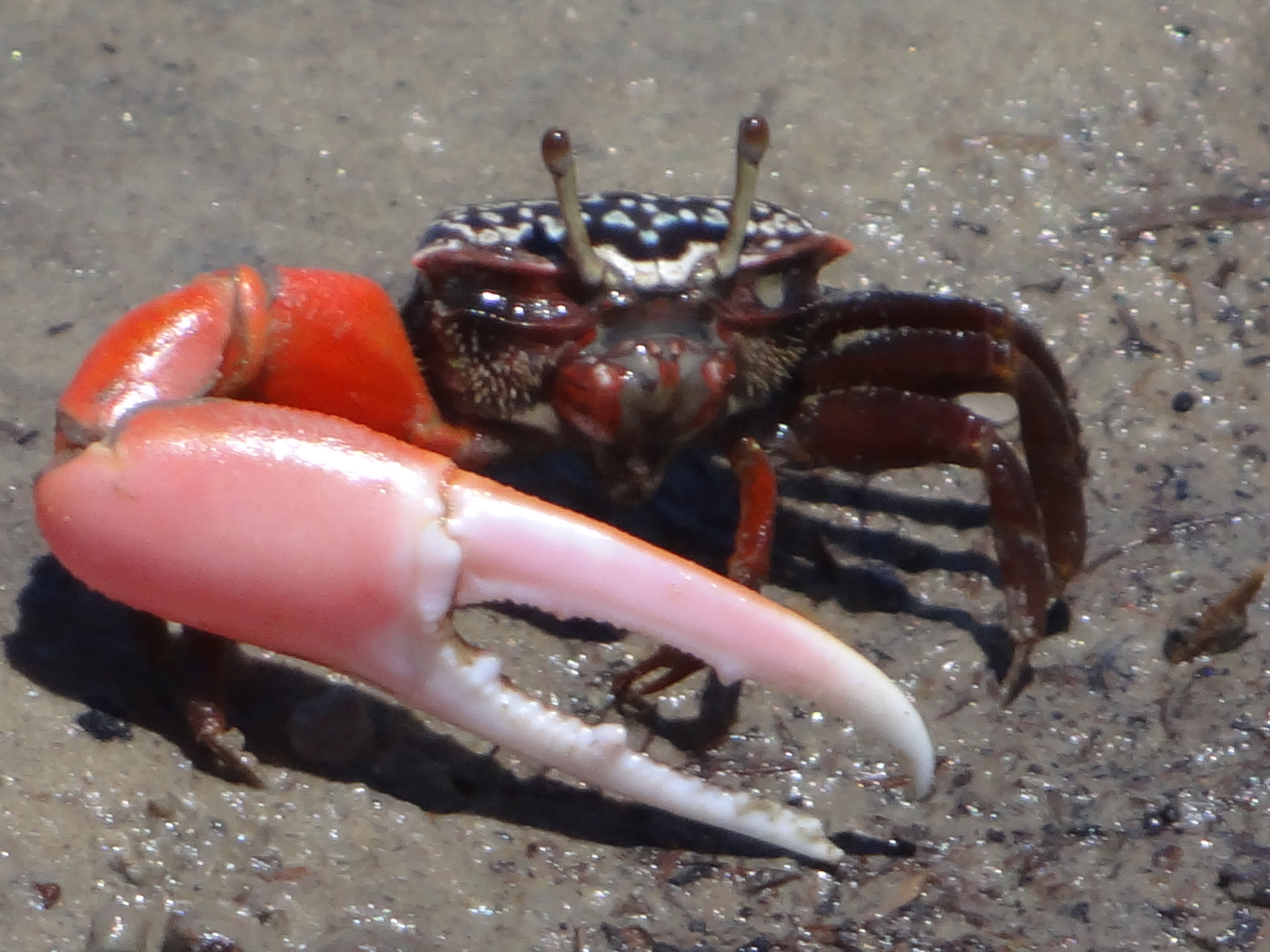Fiddler Crab Guide: East Africa
This is part 6 of a series of planned posts about identifying fiddler crabs. Previous entries include:
- How to Identify Fiddler Crabs from Photos (or in the field)
- Is It a Fiddler Crab?
- Fiddler Crabs of the Atlantic Coast of the USA
- Fiddler Crabs of West Africa and Europe
- Fiddler Crabs of Southern California, USA
Fiddler Crabs of East Africa
- Austruca occidentalis (East African Fiddler Crab)
- Cranuca inversa (Inversed Fiddler Crab)
- Gelasimus hesperiae (Western Calling Fiddler Crab)
- Gelasimus tetragonon (Tetragonal Fiddler Crab)
- Paraleptuca chlorophthalmus (Green-eyed Fiddler Crab)
- Tubuca urvillei (d’Urville’s Fiddler Crab)
|
|
Broad front species
Cranuca inversa / Inversed Fiddler Crab
Male Cranuca inversa should be the easiest of any of the species to identify so long as one can get a good look at the large claw. In this species, the tip of the dactyl (the upper finger) on the large claw has a forked shape which is completely unique to this species. Compare the tip of the upper finger of the claw in the “broad front” photo above to those in the four photos below. While the colors of the crabs are very similar, the shape of the tip of the dactyl is distinctly different.
 https://www.inaturalist.org/observations/73491591
https://www.inaturalist.org/observations/73491591
|
 https://www.inaturalist.org/observations/18730511
https://www.inaturalist.org/observations/18730511
|
 https://www.inaturalist.org/observations/18258981
https://www.inaturalist.org/observations/18258981
|
 https://www.inaturalist.org/observations/49297008
https://www.inaturalist.org/observations/49297008
|
Austruca occidentalis / East African Fiddler Crab
Austruca occidentalis looks a lot like Cranuca inversa. The carapace is predominantly black and white, with more black than white and the claw is often pink. The key feature is that the tip of the dactyl in Austruca occidentalis comes to a more “normal” point rather than the unique fork found in Cranuca inversa. Austruca occidentalis appears to have more color variation, however. In some males the claw is more red or orange rather than pink and the dactyl may be less white and closer to the same color as the rest of the claw. The color pattern of the carapace is subtly different between the two species as well: Austruca occidentalis tends to have smaller, more spotted markings while Cranuca inversa tends to have elongated, more stripe-like markings; I wouldn’t feel comfortable making identification solely on this pattern, however.
 https://www.inaturalist.org/observations/38981491
https://www.inaturalist.org/observations/38981491
|
 https://www.inaturalist.org/observations/9262381
https://www.inaturalist.org/observations/9262381
|
 https://www.inaturalist.org/observations/578653
https://www.inaturalist.org/observations/578653
|
 https://www.inaturalist.org/observations/9431179
https://www.inaturalist.org/observations/9431179
|
Paraleptuca chlorophthalmus / Green-eyed Fiddler Crab
Paraleptuca chlorophthalmus should be readily distinguishable from the other two broad front species because its carapace is predominantly blue with black markings, although sometimes it will be nearly solid one or the other color. Its legs are frequently bright red (although occasionally darkening to almost black), and the large arm and claw tend to be bright red, with only partial whitening on the fingers. The eyestalks are usually yellow-green.
Narrow front species
Gelasimus tetragonon (Tetragonal Fiddler Crab)
|
|
Gelasimus tetragonon is a wide-spread species that can be confused with Paraleptuca chlorophthalmus, despite the latter being a broad front species and the former being a narrow front species, as Paraleptuca chlorophthalmus is a relatively narrow fronted broad front species. Both species have predominantly blue and black carapace and tend to have bright red legs (which occasionally may be darker). Gelasimus tetragonon tends to have gray eyestalks, as opposed to the more yellow-green of Paraleptuca chlorophthalmus.
Gelasimus tetragonon has a lot of additional variability that does not overlap with other local species. In some places the carapace can lighten so that there is almost no blue, just a cream or pale orange with black markings. The pattern of the colors on the carapace can vary from stripes or blotches to tiny spots.
Tubuca urvillei (d’Urville’s Fiddler Crab)
Superficially, Tubuca urvillei may seem similar to the previous two species as it is also a narrow front species with a predominantly dark blue carapace with black markings and a large claw with orange-red and white colors. This superficial description fails to convey some rather striking differences that usually make it easy to pick out from the previous two.
Gelasimus hesperiae (Western Calling Fiddler Crab)
Gelasimus hesperiae is a narrow front species with a white or pale greenish-brown carapace and a distinctively shaped large claw. It never has any blue and should be readily distinguishable from all of the other species. The dactyl on the large claw is usually white or pink, while the rest of the claw usually ranges from orange to pale yellow. The dactyl is relatively thick and straight for about half its length before clearly curving to a thick point. The pollex will frequently have two very clear large teeth, one about midway along the length and one near the tip, although one or both can be absent. Like Tubuca urvillei, it has large bumps (tubercles) on the hand of the claw and will often have a noticeable groove along the base of the pollex.
 https://www.inaturalist.org/observations/67192391
https://www.inaturalist.org/observations/67192391
|
 https://www.inaturalist.org/observations/47636654
https://www.inaturalist.org/observations/47636654
|
 https://www.inaturalist.org/observations/9890177
https://www.inaturalist.org/observations/9890177
|
 https://www.inaturalist.org/observations/56720520
https://www.inaturalist.org/observations/56720520
|




























תגובות
הוספת תגובה